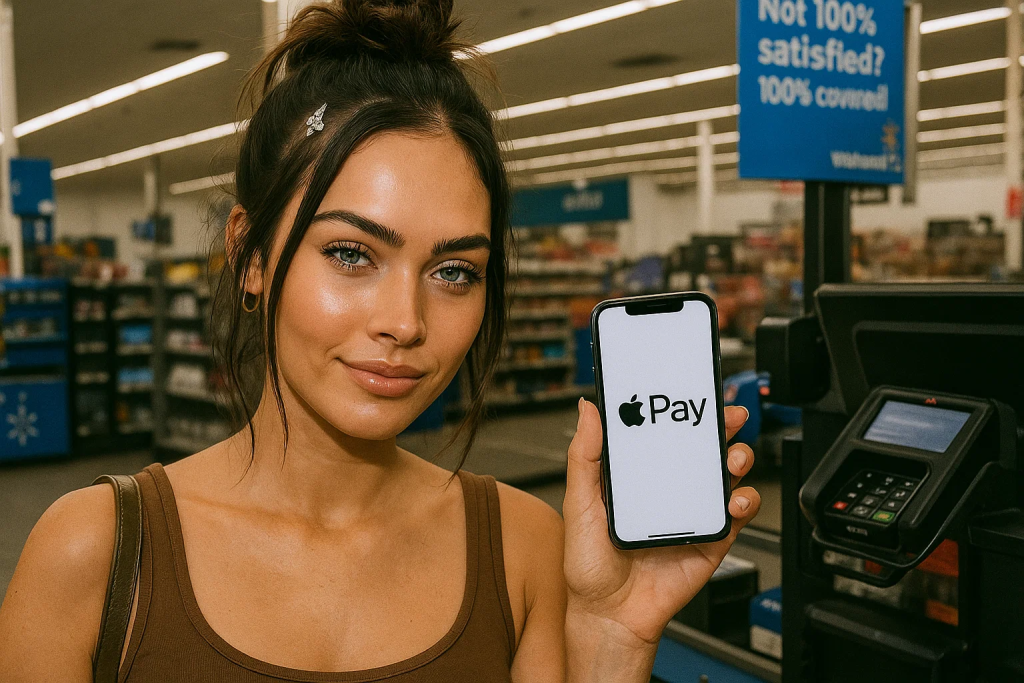Walmart Still Refuses To Accept Apple Pay In The U.S., Frustrating Shoppers Who Expect Contactless Payments
For more than a decade, Apple Pay has become a near-universal standard across U.S. retail. From small cafés to massive chains like Home Depot, Lowe’s, and Kroger, the ability to tap your phone or watch at checkout is now expected.
Yet Walmart, with more than 4,500 stores across the country, remains one of the last major holdouts. Despite daily customer complaints and mounting frustration online, Walmart still refuses to turn on Apple Pay, or even basic tap-to-pay with debit and credit cards, in its U.S. locations.

Why Walmart Won’t Allow Apple Pay
The official answer has remained consistent: Walmart wants shoppers to use Walmart Pay, its in-house system. Rather than tapping a phone or card, customers must scan a QR code displayed at checkout using the Walmart app, which then processes the payment from a stored card. For Walmart+ members, a related feature called Scan & Go lets shoppers scan items as they place them in the cart, then pay in-app without re-scanning at checkout.
While convenient in theory, Walmart Pay has two major advantages, for Walmart, not necessarily for customers:
- Full data tracking: Unlike Apple Pay, which masks personal information, Walmart Pay links every purchase directly to a shopper’s account. This allows Walmart to build detailed profiles of spending habits.
- Customer funneling: Requiring the Walmart app gives the company opportunities to push Walmart+ memberships, digital coupons, and personalized ads.
This strategy makes sense for Walmart’s bottom line, but for consumers who simply want fast, universal contactless checkout, it creates unnecessary friction.
Customers Aren’t Happy About It
The reaction is loud and often sarcastic. In online forums and comment threads, shoppers vent about being forced back into the 2000s while even small mom-and-pop stores now accept Apple Pay. Common themes include:
- Inconvenience: Many shoppers leave wallets at home, relying on their phones or watches. When Walmart rejects contactless payments, they’re stuck.
- Boycotts and avoidance: A growing number of people admit they simply avoid Walmart in favor of Target, Costco, or local chains that accept Apple Pay.
- Workarounds: Some customers buy Walmart gift cards at other stores that accept Apple Pay, then use those gift cards to shop inside Walmart.
One particularly telling frustration came from shoppers who noticed that Walmart terminals do technically support NFC but are deliberately disabled. In some cases, employees said the terminals briefly allowed tap-to-pay before corporate orders shut it down overnight.
The Privacy Factor
Many customers point to privacy as the real wedge. Apple Pay prevents retailers from collecting specific transaction details tied to a person. By disabling it, Walmart ensures that if you want the speed of digital checkout, you have to go through its app and allow purchase tracking. Some shoppers have even joked that the company knows what you’re buying anyway, thanks to cameras, license plate readers, and facial recognition, but Apple Pay still denies them the valuable first-party transaction data.
The Global Comparison
Ironically, Walmart stores in Canada have accepted Apple Pay since 2020. Shoppers there can tap their phones or watches like at any other retailer. Meanwhile, in the U.S., Walmart remains stuck in a strange contradiction: the world’s largest retailer refusing to accept one of the world’s most common payment methods.
The U.S. also lags behind other countries in general payment adoption. In places like the U.K., Australia, and Canada, nearly every business that accepts cards also accepts tap-to-pay by default, whether from a physical card or a mobile wallet. In the U.S., customers are still asked to swipe, dip, or sign, a frustration that feels increasingly outdated in 2026.
Will Walmart Eventually Fold?
History suggests that change is possible. Home Depot, Lowe’s, and Kroger all once resisted Apple Pay, trying their own proprietary systems. Eventually, customer demand and competitive pressure forced them to switch. Now, Walmart stands nearly alone.
For now, the company shows no sign of budging. As long as Walmart Pay exists and provides data advantages, executives may decide it’s worth the customer irritation. But with even loyal shoppers complaining they’re turning to Target, Costco, or Amazon for the sake of convenience, the strategy could backfire.
What Shoppers Can Do
If Walmart’s refusal to accept Apple Pay affects you, there are a few options:
- Bring a physical card as backup whenever you shop there.
- Use Walmart Pay if you don’t mind downloading the app and linking your cards.
- Buy Walmart gift cards elsewhere at stores that accept Apple Pay, then use them at Walmart.
- Shift purchases to competitors who make checkout easier.
The Bigger Picture
This isn’t just about technology, it’s about control. Apple Pay represents customer privacy and universal convenience. Walmart Pay represents retailer control and data monetization. For shoppers, it’s a clash between what’s easiest at checkout and what’s most valuable for the corporation.
Until something breaks, whether customer loyalty, regulatory pressure, or competitive necessity, Walmart will likely keep ignoring the daily stream of complaints. For now, millions of American shoppers remain stuck swiping or dipping while nearly everywhere else in the country has moved on to a simple tap.